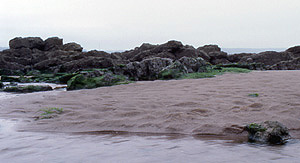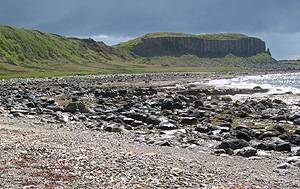Further information on where to look - Sediment shores are generally fairly easy to work though it is still worth knowing exactly where to look and what to look for.
Muddy shores
 The fauna of these habitats depends upon tidal flow, salinity, substrate etc. Where there is less brackish water influence, the fauna may change to contain elements from the sandy shore and gravel / mud shores.
The fauna of these habitats depends upon tidal flow, salinity, substrate etc. Where there is less brackish water influence, the fauna may change to contain elements from the sandy shore and gravel / mud shores.
Associated species include:
- Mytilus edulis
- Ostrea edulis
- Cerastoderma edule
- Abra tenuis
- Scrobicularia plana
- Macoma balthica
- Tapes decussatus
- Mya arenaria
- Littorina littorea
- Littorina saxatilis
- Littorina obtusata
- Peringia ulvae
- Crepidula fornicata (S. to E.)
- Retusa obtusa
- Aeolidiella alderi (S. & W.)
- Lepidochitona cinerea
Sandy shore
 The fauna of a sandy shore will to some extent depend on the degree of exposure and the size of the sand grains, and therefore, the stability of the sand. In an ideal sheltered sandy environment such as on St. Martins, Scilly, or Oxwich Bay, South Wales, the mollusc fauna is relatively rich, although the diversity is lower than on a sheltered rocky or mixed shore. In less favourable conditions such as on the long stretches of sand on the Lincolnshire coast, the diversity is considerably reduced. Most of the molluscs of a sandy environment are infaunal, comprising mostly bivalves with their gastropod predators or scavengers. Generally there is less biogeographical variation in sandy shore faunas.
The fauna of a sandy shore will to some extent depend on the degree of exposure and the size of the sand grains, and therefore, the stability of the sand. In an ideal sheltered sandy environment such as on St. Martins, Scilly, or Oxwich Bay, South Wales, the mollusc fauna is relatively rich, although the diversity is lower than on a sheltered rocky or mixed shore. In less favourable conditions such as on the long stretches of sand on the Lincolnshire coast, the diversity is considerably reduced. Most of the molluscs of a sandy environment are infaunal, comprising mostly bivalves with their gastropod predators or scavengers. Generally there is less biogeographical variation in sandy shore faunas.
Associated species include:
- Angulus tenuis
- Fabulina fabula
- Mactra stultorum
- Donax vittatus
- Ensis siliqua
- Ensis arcuatus
- Ensis ensis
- Solen marginatus
- Acanthocardia echinata
- Abra alba
- Pharus legumen
- Spisula solida
- Chamelea gallina
- Lutraria lutraria
- Polinices polianus
- Polinices catenus
- Hinia reticulata
- Epitonium spp.
- turrids
- Acteon tornatilis
Where there is a siltier element, the fauna may also include:
Mixed shores
 Mixed shores have many of the elements of a very sheltered rocky shore but have a variety of substrate types, particularly gravel and mud. They have many of the species found on semi-exposed and sheltered rocky shores, and the sandy shore list, but also a number of infaunal molluscs especially bivalves.
Mixed shores have many of the elements of a very sheltered rocky shore but have a variety of substrate types, particularly gravel and mud. They have many of the species found on semi-exposed and sheltered rocky shores, and the sandy shore list, but also a number of infaunal molluscs especially bivalves.
Associated species include:
- Gibbula magus
- Hinia reticulata
- Crepidula fornicata
- Calyptraea chinensis
- Philine aperta
- Antalis spp.
- Anomia ephippium
- Oyster species
- Parvicardium exiguum
- Cerastoderma edule
- Loripes lucinalis (S & SW)
- Lucinoma borealis
- Spisula subtruncata
- Mya truncata
- Tapes decussatus
- Tapes aureus
- Venerupis senegalensis
- Venus verrucosa
